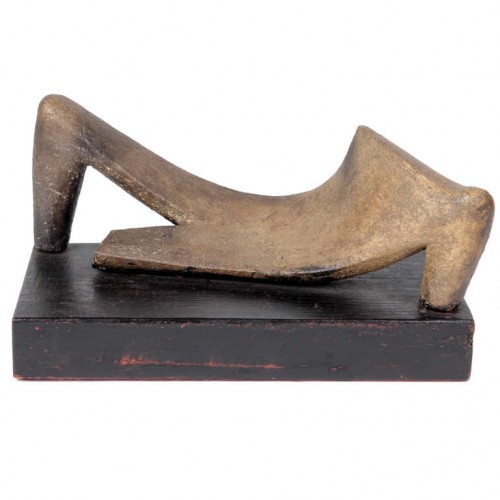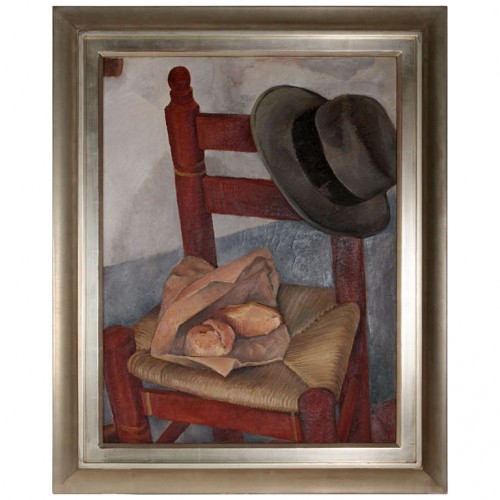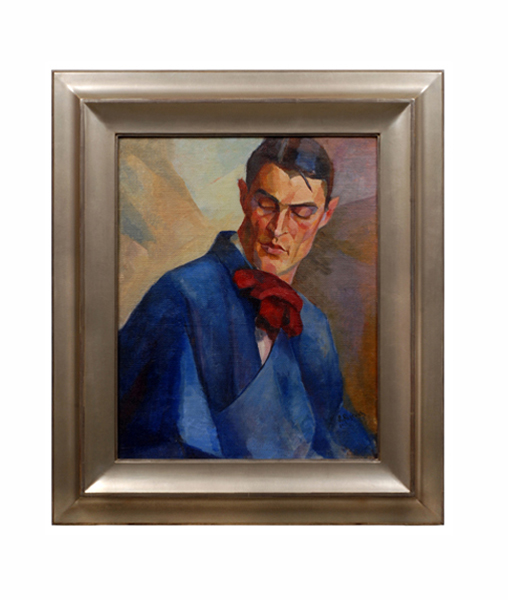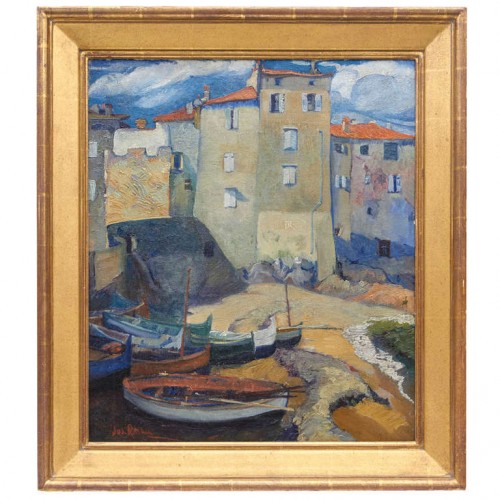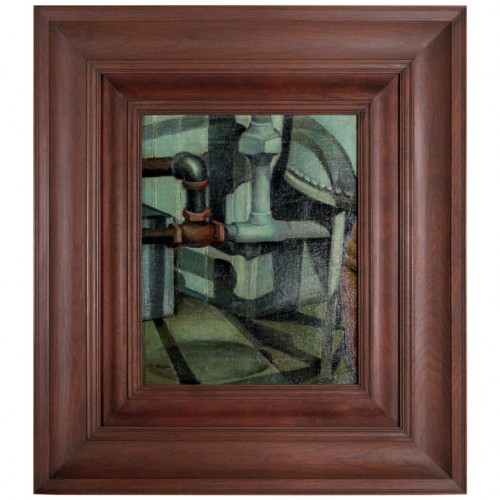20th Century American Painting & Sculpture

20th Century American Painting & Sculpture
-
Duval Eliot “Still life”, Oil on canvas, wood frame c. 1945
DUVAL ELIOT (1909-1990) USA
Still life c. 1945
Oil on canvas, wood frame
Signed: Duval Eliot (lower right)
Painting H: 30” x W: 24”
Frame H: 38” x W: 32”
Duval Eliot, nee’ Ruby Duval Bearden, was born in Arkansas, and at a young age moved with her family to California. After going to Hollywood High School, she attended The Los Angeles Trade Technical College (then known as Frank Wiggins Trade School), studying Commercial Art and Design. While there, she began her art career as a men’s fashion illustrator. Then, because of her immense interest in art, immediately enrolled in Art Center School in Los Angeles, being one of their first students. She studied landscape painting (watercolor and oil), portrait, life drawing and illustration with Barse Miller and with Joseph Henniger, life drawing. At Art Center she continued studying all facets of commercial art and simultaneously worked at the Columbia Advertising Agency designing newspaper layouts and fashion illustrations for the major Los Angeles department stores such as I. Magnin, The Broadway, I. Miller, Wetherby Kayser, and Sak’s in Beverly Hills.
Throughout the 1940’s, Duval continued to create watercolor landscapes of Southern California and the West, while illustrating for J.J. Hagarty. Commercially, her prime focus was free-lance illustration, which could be created with a young child in tow, finding interesting work at the “Western Family Magazine,” for whom she did illustrations for over ten years. She also illustrated children’s storybooks and textbooks for MacMillian and L.W. Stinger publishing houses, meanwhile creating Fashion Advertisements and billboards in full color for Phelps & Terkel for several years and billboards for Silverwoods Department Store. For this work, Duval received the Western Art Directors Award in 1946.
During the post World War II years, Duval honed her fine art techniques. She studied with such notable artists as: Barse Miller, Hardy Gramatky and Ejnar Hansen (watercolor) and also with Hansen, (landscape & portrait painting in oil). In 1948, in The Fourth Annual Los Angeles Exhibition at The Greek Theater in Griffith Park, she won 1st Prize for her watercolor entitled “End of the Trail” among her peers of 326 entrants for painting, including Francis De Erdely, Lorser Feitelson, Conrad Buff, James Couper Wright, Frode N. Dann, Joshua Meador, Dan Lutz, and Chas. Payzant. She also studied painting with Conrad Buff, J.C.Wright, Design and Abstract Painting with Leonard Edmonson, and later, painting in acrylic with 2 years of intensive color with Guy MacCoy and silk-screen Serigraphy with Mario De Perentes. Duval also became close friends with Milford Zornes.
Duval became active in “The Southern California Designer Craftsmen” (S.C.D.C.) She won many awards and exhibited extensively throughout the 1950’s and 1960’s at Barnsdall Municipal Art Gallery, Pasadena Art Museum (paintings and enamels}, Gallery 333 on La Cienega. In the 1940s, she turned towards more formal subject matter including landscape and still life and honed her fine art techniques in watercolor, oil, acrylic, and printmaking.
She participated in several group exhibitions in the Los Angeles area in the late 50s and early 60s. Her work was featured in solo exhibitions at the Jack Carr Gallery in Pasadena in 1976 and the Brand Library Gallery in Glendale in 1988.
Duval was also an active member and on the boards of “The Pasadena Society of Artists”, ”The Los Angeles Art Association”, “Women Painters of the West”, as well as S.C.D.C., participating in numerous group (Design 6, 7, 8, and 9 at the Pasadena Art Museum) and one man shows in the vicinities of Pasadena, Glendale, Santa Barbara and Claremont. She was represented in Paris by two silk screen serigraphs at The Exposicion Internacionale des Federacion Femenine at The Museum des Arts Decoratifs in 1971.
Duval Eliot was also represented in The Los Angeles County Art Museum’s show “MADE IN CALIF” in 2001 with “Chavez Ravine” and “3rd St. Traffic”.
-
Gertrude Burgess Murphy American Modern Post-War Reclining nude sculpture c. 1950
GERTRUDE BURGESS MURPHY (b. 1899) USA
Reclining nude sculpture c. 1950
Fired and glazed earthenware on a wooden base
Marks: original paper exhibition label (San Francisco Museum of Art, Rental Gallery); tape with the name of the artist
For more information on Murphy see: Who Was Who in American Art, ed. Peter Hastings Falk (Madison, Conn.: Sound View Press, 1985), p. 439.
H: 5 7/8” x L: 10 5/8” x D: 5”
Price: $11,500
-
Victor Arnautoff, The Felt Hat, Oil on Canvas c. 1930
VICTOR ARNAUTOFF (1896-1979) USA
The Felt Hat c. 1930
Oil on canvas, white gold frame
Signed: V. Arnautoff, lower right
Exhibited: Art Center San Francisco, 1931 (see image of the review in the San Francisco Examiner, July 12th, 1931)
For more information see: The New Deal for Artists, Richard D. McKinzie (Princeton, NJ: Princeton University Press, 1973), Coit Tower, San Francisco : Its History and Art
Painting: H: 26” x W: 21”
Framed: H: 32 ½” x 27 ½”Price: $60,000
Victor Arnautoff created paintings and watercolors, focusing on portraits, still lifes and rural landscapes in his early years, and moved to more socially conscious themes later in his career. Arnautoff was a native of Russia, to which he returned during the 1960s after thirty years in the United States. He came to San Francisco from Russia via China, bringing his wife and children with him, and studied at the California School of Fine Arts studying with Ralph Stackpole and Edgar Walter before going to Mexico. There he worked as an assistant to the famous Mexican muralist Diego Rivera. During the 1930s, Arnautoff worked as project director and one of the artists selected to create the famed Coit Tower murals, he played a key role in determining the political and social content of the frescoes painted in the San Francisco landmark. His own contribution, City Life, appears to be a lively, non-political melding of downtown San Francisco scenes; however, closer study reveals two leftist newspapers on the newsstand, while the city’s most mainstream daily, the San Francisco Chronicle, is strangely missing. Arnautoff also painted frescoes in the Military Chapel at San Francisco’s Presidio, in the Anne Bremer Library of the San Francisco Art Institute, and in high schools and other buildings in the Bay Area. He was a professor of art at Stanford University from 1939 until his retirement in 1963.
-
Zygmund Sazevich “Portrait of Victor Arnautoff” Oil on canvas 1925
ZYGMUND SAZEVICH (1899-1968)
Portrait of Victor Arnautoff 1925
Oil on canvas
Signed: Z. Sazevich 1925 (lower right)
Framed: H: 34 5/16” x W: 29 9/16”
Price: $65,000
Zygmund Sazevich was born in Russia in 1899, and studied briefly at the University in Kazan in 1917, before traveling to Manchuria where he lived and worked as an actor and stage scenery painter. He emigrated to the U.S. via Japan in the early 1920s and entered the School of Architecture at the University of California, Berkeley, supporting himself by working as a house painter and helping stage plays for a local Russian theater company. Sazevich met Russian artist Eugene Ivanoff, and together they shared living quarters and studied at the California School of Fine Arts in San Francisco. Sazevich was awarded two scholarships, one in painting and one in sculpture. During the 1920’s Sazevich exhibited with the San Francisco Art Association, and in 1929 won first prize at their annual exhibit, followed by several sculpture commissions. That same year Sazevich and Ivanoff traveled to live and work in Paris. Back in San Francisco in 1931, his work was included in a show of garden sculptures at the California Palace of the Legion of Honor, along with works by Adaline Kent, Ruth Cravath, and others. By 1935 he was working as a W.P.A. muralist. Sazevich and his wife Zena, a decorator, purchased a home in the City, which they filled with Sazevich’s sculptures, woodcarvings, and hand-made furniture. In 1939 Sazevich exhibited at San Francisco’s Golden Gate International Exposition. His cast terrazzo sculpture Mississippi won the 1940 purchase prize at the annual San Francisco Art Association exhibition, and he had a one-man show at the San Francisco Museum of Art in 1941. During World War II, Sazevich worked in a shipyard creating wood patterns, and in later years he designed and made hand-blocked Christmas cards that were in great demand. His clients included celebrities such as Greer Garson, Joan Fontaine, and Red Skelton. From the late 1940s until the 1960s, Sazevich taught art classes, both at the California School of Fine Arts and at Mills College in Oakland. He continued to exhibit at the San Francisco Museum of Art through the 1950s, and in 1953 was featured in the museum’s Four Sculptors of the West show. Sazevich also had two solo shows at Mills College in 1950 and 1954, and a show at Raymond & Raymond in San Francisco in 1951. Zygmund Sazevich passed away in San Francisco in 1968. In 1982 his work was included in The Oakland Museum’s seminal exhibition 100 Years of California Sculpture.
Though his works are rare today, Zygmund Sazevich was a prolific, versatile and highly-regarded San Francisco Bay Area artist and instructor whose passion for his medium was evident not only in his sculptures and carvings, but also in his drawings and paintings. Sazevich believed that the two-dimensional rendering of the subject was integral to the process of sculpture, along with the necessity for the artist to have a feeling for the material with which he worked. His convictions were reflected in the great variety of woods, metals, and stone he used to create his sculptures, as well as in his paintings.
-
Gerrit V. Sinclair “Third Ward Milwaukee”, Oil on board, lemon gold frame c. 1940
GERRIT V. SINCLAIR (1890-1955) USA
Third Ward Milwaukee c. 1940
Oil on board, lemon gold frame
Signed: GV Sinclair (lower right corner on front of painting)
For more information see: Who Was Who in American Art (Madison, Conn.: Sound View Press, 1985) p. 571.
Painting H: 15” x W: 20”
Framed H: 20 7/16” x W: 25 7/16”
Price: $27,500
Gerrit V. Sinclair was born in Grand Haven, Michigan in 1890. He studied art at the School of the Art Institute of Chicago from 1910 to 1915. His most well known teachers at the Art Institute were John Vanderpoel and John Norton. In 1917 the artist enlisted in the Army Ambulance Corps and served in northern Italy and Austria. Scenes from his experience abroad are recorded in his works of the early 1920s. Following the war, Sinclair settled in Milwaukee, Wisconsin, where he became a member of the faculty of the Layton School of Art upon the school’s founding in 1920. He continued to teach at the Layton School and at the Oxbow Summer School of Art in Saugatuck, Michigan until his retirement in 1954. Sinclair is recognized both as an important artist and teacher from the Great Lakes region. During his lifetime Sinclair’s paintings were exhibited at the Salon d’Automne in Paris, the Salon Printemps in Paris, the Pennsylvania Academy of Fine Arts, the National Academy of Design, the Whitney Museum in New York, the New York Watercolor Club, the Brooklyn Museum, the Corcoran Gallery of Art in Washington D.C., the Carnegie Institute in Pittsburgh, the Art Institute of Chicago and in many other museums and galleries. He received numerous prizes and commissions for his work including a W.P.A. mural commission for the Federal Building in Wassau, Wisconsin. Sinclair was a member of Wisconsin Painters & Sculptors, Wisconsin Federation of the Arts and the Wisconsin Painting Museum. His style is a blend of realism and Impressionism but is clearly modern in its abstract concern for composition and color. Sinclair is best known for his regionalist paintings of rural and urban Wisconsin. His farm scene entitled ”Spring in Wisconsin” was exhibited at the 1939 World’s Fair in New York. Gerrit V. Sinclair died in Milwaukee, Wisconsin in 1955.
-
Joseph Raskin, Seaside scene, Oil on Canvas c. 1920 -1925
JOSEPH RASKIN (1897-1981) USA
Seaside scene c. 1920 -1925
Oil on canvas, gold leaf frame
Signed: Jos. Raskin (lower left)
For more information see: Who Was Who in American Art,
(Madison, Conn.: Sound View Press, 1985), p. 505Canvas: 25 1/4” x 21 1/4”
Frame: 31 1/4” x 26 3/4”Price: $35,000
Born in Nogaisk, Russia, Joseph Raskin made a name for himself as a painter in New York City, where he was also recognized as an etcher, teacher and writer. He studied at the National Academy of Design and, in 1921, received a fellowship from the Louis Comfort Tiffany Foundation. A member of the American Artists Congress, Raskin’s work was exhibited at the Schervee Gallery (Boston) in 1927, Tricker Gallery in 1939, the Schneider-Gabriel Gallery in 1941, Steinway Hall in 1942, and the American Artists Association in 1945. Raskin’s work may be found in several museum collections including the Carnegie Institute in Pittsburgh, the Pennsylvania Academy of Fine Arts in Philadelphia, the Virginia Museum of Fine Arts in Richmond, and the Corcoran Gallery of Art and National Academy of Design, both in Washington, D.C.
-
Walter Paul Suter, American Art Deco glazed pottery sculpture 1929
WALTER PAUL SUTER USA
AMERICAN ENCAUSTING TILING CO. New York, NY
Art Deco Seated Female Figure with Draped Skirt and Holding an Art Deco Vase 1929
Hand-modeled and molded cream glazed earthenware figure with gold and silver details on a separate, but matching black glazed earthenware base.
Signed: SUTER ‘29 (under glaze on back right hand corner)
H: 13″ x D: 7 1/2″ x W: 9″
Price: $14,500
Walter Paul Suter was born in Basel, Switzerland in 1902 and studied there at the School of Fine and Applied Arts. He moved to the United States in 1924 and settled in New York. He was a member of the American Ceramic Society, as well as the Society of Swiss Painters, Sculptors & Architects. In 1932 Suter won first prize in the Robineau Member Exhibition in Syracuse. He was a member of the American Encaustic Tiling Company in NYC.
-
Otis Oldfield, Water Pipes and Shadows, Oil on Canvas c. 1920
OTIS OLDFIELD (1890-1969) USA
“Water pipes and shadows” c. 1920
Oil on canvas, walnut frame
Signed: Otis Oldfield (lower left)
For more information see: Otis Oldfield 1890-1990, Centennial retrospective exhibition (San Francisco, CA: Inkwell Publishing, 1990).
Painting: H: 16 1/8” x W: 13”
Framed: H: 28 ¼” x W: 25 1/8”Price: $42,500
***The Metropolitan Museum of Art in New York owns a famous Gelatin silver print photograph by Morton Schamberg from 1916 entitled “God”. This image is akin to Duchamp’s “Fountain” and is an iconic Dadaist assemblage of plumbing pipes mounted on a miter box. The “Water Pipes and Shadows” painting by Otis Oldfield similarly brings a certain animation and personality to an under sink composition of mundane drain pipes in a sophisticated “Rayonist” or “Cubist” stylization. Otis Oldfield was born in Sacramento, California in 1890. He enrolled in the Best Art School in San Francisco in 1909 and continued his studies at the Academie Julian in Paris. Returning to the U.S., Oldfield settled briefly Sacramento before returning to San Francisco to accept a post as a teacher at the California School of Fine Art. Oldfield developed a bold modernist style, which caused some controversy among critics covering his exhibits. In 1936 Oldfield was one of a group of San Francisco artists chosen for a WPA project to paint murals in San Francisco’s Coit Tower. Following WW II, Oldfield taught at the California College of Arts and Crafts in Oakland. He died in San Francisco in 1969. -
Arrigo Varettoni de Molin, “Conflict”, Oil on canvas 1945
ARRIGO VARETTONI DE MOLIN (1902-1985)
Conflict 1945
Oil on canvas
Signed: de molin 1945 (lower left on front of canvas)
For more information see: Who’s Who in America, Series II, no. 11 (November 1, 1941) p. 6.
Canvas: H: 38” x W: 44”
Framed: H: 45 ½” x W: 51”
The work of Arrigo De Molin shows a genuine understanding of everyday people. His paintings have sympathy, humor and a touch of gentle irony. The artist himself, after immigrating to the United States from Borca di Cadore, Italy in 1921, had the opportunity to study art and design at Cooper Union and the Art Students’ League. His first enterprises as a theatrical designer and painter of community and church murals heavily influenced his later portrayals of New York City life. These, his most revered works, were exhibited at the Vendome Art Galleries in 1941. Later in life, de Molin, persevered as an independent artist, diversifying his talents to span design and invention.
-
Gianni L. Cilfone “After the Rain” Oil on canvas 1928
GIANNI L. CILFONE (1908-1990) USA
“After the Rain” 1928
Oil on canvas, contemporary quarter sawn oak pegged frame with yellow gold filet.
Signed: Cilfone, 1928 (lower left corner)
Marks: Illinois Academy of Fine Arts, Second Annual Exhibition 1928, Gianni L. Clifone, 905 South Ashland Boulevard, “After the Rain,” $500 (paper label).
Exhibited: Illinois Academy of Fine Arts, Second Annual Exhibition 1928, Art Institute of Chicago 1928
For more information see: Who Was Who in American Art (Madison, Conn.: Sound View Press, 1985) p. 115.
Canvas: H: 30” x W: 40”
Framed: H: 38” x W: 48”
Gianni Cilfone emigrated with his family from San Marco, Italy to Chicago at the age of five. After studying at the Art Institute of Chicago, Cilfone took lessons from Hugh Breckenridge and John F. Carlson. His consistently won many prizes from the Chicago Gallery Association throughout the 1930s and 40s. He exhibited at the Hoosier Salon between 1949 and 1958, at the North Shore Arts Association, at the Association of Chicago Painters and Sculptors, and at the Art Institute of Chicago in 1919 and 1928.
-
Arthur N. Colt, “The Wrestlers”, Oil on canvas c. 1938
ARTHUR N. COLT (1889-1972) USA
The Wrestlers c. 1938
Oil on canvas
Signed: A. N. Colt in lower right corner
For more information on Colt see: Who Was Who in American Art (Madison, Conn.: Sound View Press, 1985). p.125. Hove, Arthur, ed. Wisconsin Alumnus Vol. 61, No. 9 (January 1960), “Portrait Patterns” Art Digest v. 9 (December 15, 1934) p. 7
Canvas: H: 29 ½” x W: 34”
Framed: H: 38 ½” x W: 43”
Arthur Colt studied painting at the Art Institute of Chicago and in Paris. He was not only an important Wisconsin painter but also an influential teacher. He taught at the University of Wisconsin, Madison, founded a summer art colony at Black River and Devil’s Lake, WI and went on to form the Colt School of Art. Arthur Colt exhibited at the Madison Salon of Art Exhibition in 1934.


